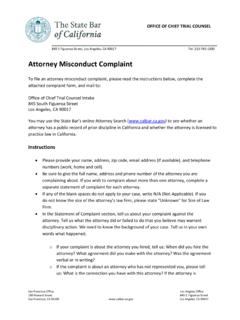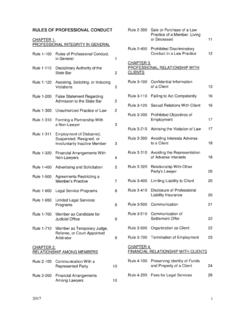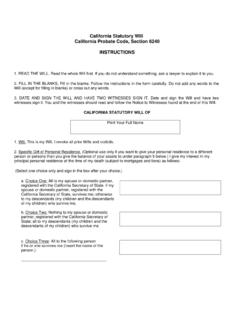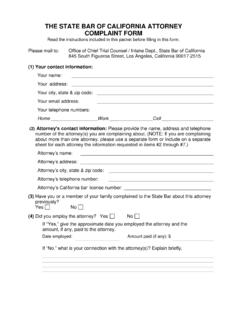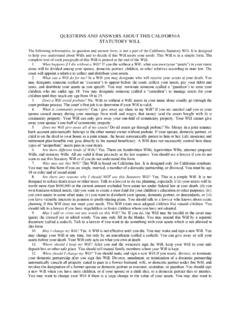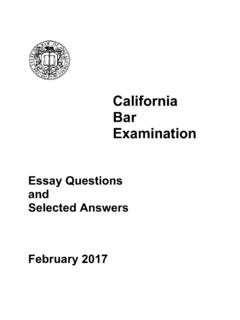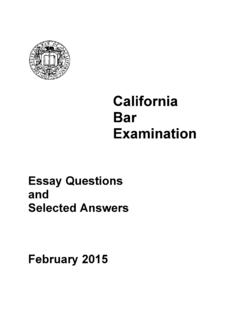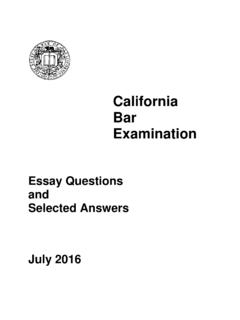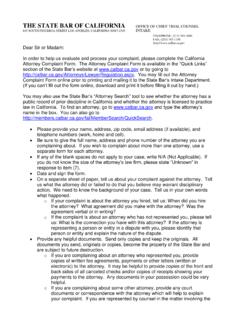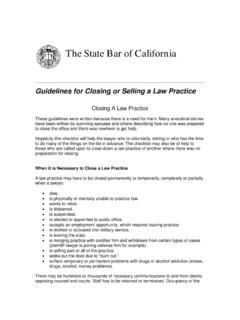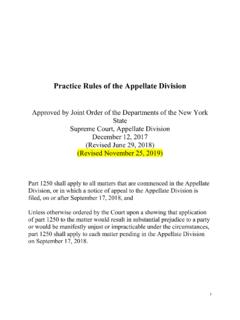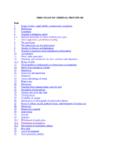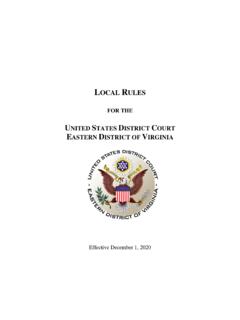Transcription of DIVISION 1. ADMISSION TO PRACTICE LAW IN CALIFORNIA
1 TITLE 4. ADMISSIONS AND EDUCATIONAL STANDARDS. Adopted July 2007. DIVISION 1. ADMISSION TO PRACTICE LAW IN CALIFORNIA . Chapter 1. general provisions Rule Authority The CALIFORNIA Supreme Court exercises inherent jurisdiction over the PRACTICE of law in CALIFORNIA . The Committee of Bar Examiners ( the Committee ) is authorized by law to administer the requirements for ADMISSION to PRACTICE law; to examine all applicants for ADMISSION ; and to certify to the Supreme Court for ADMISSION those applicants who fulfill the requirements. 1. Rule adopted effective September 1, 2008. Rule What these rules are These rules apply to persons seeking to PRACTICE law in CALIFORNIA . Nothing in these rules may be construed as affecting the power of the CALIFORNIA Supreme Court to exercise its inherent jurisdiction over the PRACTICE of law in CALIFORNIA . Rule adopted effective September 1, 2008. Rule Definitions These definitions apply to the rules in this DIVISION unless otherwise indicated.
2 (A) An American Bar Association Approved Law School is a law school fully or provisionally approved by the American Bar Association and deemed accredited by the Committee. (B) An attorney applicant is an applicant who is or has been admitted as an attorney to the PRACTICE of law in any jurisdiction. (C) The Attorneys' Examination is the CALIFORNIA Bar Examination for which attorney applicants may apply, provided they have been admitted to the active PRACTICE of law in a United States jurisdiction at least four years immediately prior to the first day of administration of the examination and have been in good standing during that period. The Attorneys' Examination includes essay questions and performance tests of the general Bar Examination but not its multiple-choice questions. 1. Business & Professions Code 6046. 1 of 27. (D) A CALIFORNIA accredited law school is a law school accredited by the Committee but not approved by the American Bar Association.
3 (E) The CALIFORNIA Bar Examination is the examination administered by the Committee that an applicant must pass to be certified to the CALIFORNIA Supreme Court as qualified for ADMISSION to PRACTICE law in CALIFORNIA . The CALIFORNIA Bar Examination includes the general Bar Examination and the Attorneys'. Examination. (F) The Committee is the Committee of Bar Examiners of the State Bar of CALIFORNIA or, unless otherwise indicated, a subcommittee of two or more of its members whom the Committee authorizes to act on its behalf. (G) A general applicant is an applicant who has not been admitted as an attorney to the PRACTICE of law in any jurisdiction. (H) The general Bar Examination is the CALIFORNIA Bar Examination required of every general applicant. The general Bar Examination consists of multiple- choice questions, essay questions, and performance tests. (I) The First-Year Law Students' Examination is the examination administered by the Committee that an applicant must pass, unless otherwise It includes questions on contracts, torts, and criminal law.
4 (J) An informal conference is defined in Rule (K) The Office of Admissions ( Admissions ) is the State Bar office authorized by the Committee to administer examinations and otherwise act on its behalf. (L) Receipt of a document the Committee sends an applicant is (1) calculated from the date of mailing and is deemed to be five days from the date of mailing to a CALIFORNIA address; ten days from the date of mailing to an address elsewhere in the United States; and twenty days from the date of mailing to an address outside the United States; or (2) when the Committee delivers a document physically by personal service or otherwise. (M) Receipt of a document sent to the Committee is when it is physically received at the Office of Admissions. (N) Senior Executive means Senior Executive, Admissions or that person's designee. 2. Business & Professions Code 6060(h). 2 of 27. (O) An unaccredited law school is a correspondence, distance-learning, or fixed- facility law school operating in CALIFORNIA that the Committee registers but does not accredit.
5 (P) For purposes of calculating law study credit toward meeting the legal education requirements necessary to qualify to take the First-Year Law Students'. Examination and CALIFORNIA Bar Examination, a year is defined as the law study successfully completed in the time between the same calendar dates for consecutive calendar years, minus one day. Rule adopted effective September 1, 2008; amended effective July 22, 2011. Rule Confidentiality Applicant records are confidential unless required to be disclosed by law;3 required by the State Bar's Executive Director, Chief Trial Counsel, or general Counsel to fulfill their responsibilities for regulation of the PRACTICE of law; or authorized by the applicant in writing for release to others. Rule adopted effective September 1, 2008. Rule Submissions (A) A document filed with the Committee pursuant to these rules must be completed according to instructions; verified or made under penalty of perjury;4 and submitted with any required fee.
6 (B) A document, which must be complete as defined by the instructions for filing, is deemed filed upon receipt. (C) Fingerprints provided by applicants are used to establish identity and disclose criminal records in CALIFORNIA or elsewhere. Fingerprint records are confidential and for official use of the Committee and the State Bar. (D) Information on an examination application that is not required but submitted voluntarily, including ethnic survey and identification information furnished with applications to take the CALIFORNIA Bar Examination, is separated from the applications at initial processing and may not be associated with applicants, their files, or their examination answers during grading unless there is reasonable doubt about the identity of a person taking an examination and the Committee requires the information to verify identity. Rule adopted effective September 1, 2008; amended effective July 22, 2011.
7 3. Evidence Code 1040, Business & Professions Code , , 6086, and 4. Code of Civil Procedure 3 of 27. Rule Investigations and hearings In conducting an investigation or hearing, the Committee or the State Bar Court may receive evidence; administer oaths and affirmations; and compel by subpoena the attendance of witnesses and the production of documents. Rule adopted effective September 1, 2008. Rule Statistics The Committee may publish statistics for each examination in accordance with its policies. Rule adopted effective September 1, 2008. Rule Extensions of time The time limits for Committee actions specified in these rules are norms for processing. The time limits are not jurisdictional and the Committee may extend them for good cause. Rule adopted effective September 1, 2008. Rule Review by Supreme Court An applicant refused certification to the Supreme Court of CALIFORNIA for ADMISSION to PRACTICE law in CALIFORNIA may have the action of the Committee reviewed by the Supreme Court of CALIFORNIA in accordance with its procedures.
8 Rule adopted effective September 1, 2008. Rule Fees The Committee may set reasonable fees, subject to approval of the Board of Trustees, for its services such as application filing, reports, copying documents and providing letters of verification. Rule adopted effective November 14, 2009; amended effective January 1, 2012. Rule Meetings of the Committee (A) Open meeting policy Meetings of Committee are open to the public unless closed pursuant to the grounds provided below. Meeting space for members of the public may be limited and the State Bar is not obligated to provide seating for all members of the public in attendance. 4 of 27. (B) Location of meetings Meetings of Committee should be held in CALIFORNIA . Meetings may be held outside of CALIFORNIA in special circumstances when approved by the Executive Director or his or her designee. (C) Notice, late items, and emergency meetings (1) Notice of regular and special meetings of the Committee must be posted on the State Bar's website no fewer than five days before the meeting.
9 The notice must include the date and place of the meeting, the agenda, and the starting time. (2) No item may be added to an agenda after the five-day notice period and no meeting may be called without notice except in an emergency. An emergency means those circumstances that call for immediate action before the next regular meeting of the Committee. If an emergency can be resolved by unanimous consent without discussion, the board-appointed body may act by fax poll, e-mail, or other electronic means without meeting. A report of action taken in emergencies must be made at the next regular meeting and indicated on its agenda. (D) Closed sessions The Committee and State Bar staff and others who are reasonably necessary for consideration of a closed session matter may attend the closed session at the discretion of the Committee's chair to discuss, deliberate, or take action upon any of the following: (1) pending or prospective litigation.
10 (2) matters designated confidential by the Committee's charge, these rules , or otherwise by law;. (3) matters related to the moral character, competence, or physical or mental health of an individual;. (4) allegations of criminal or professional misconduct;. (5) applications, petitions, requests, investigations, opinions, complaints, recommendations, or reports regarding matters delegated to the Committee by law or the Board of Trustees;. (6) proposals, negotiations, or discussions related to contractual, labor, business, or legislative matters;. 5 of 27. (7) matters related to the development, administration, or grading of an examination;. (8) matters related to laws school regulated by the Committee that involve individual students or information related to a law school's operations that is not generally known or reasonably ascertainable by others, and by which another law school or others could obtain an advantage over the law school; or (9) matters relating to internal management of the Committee.
